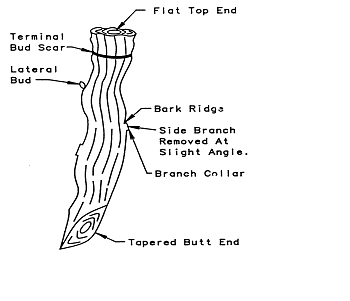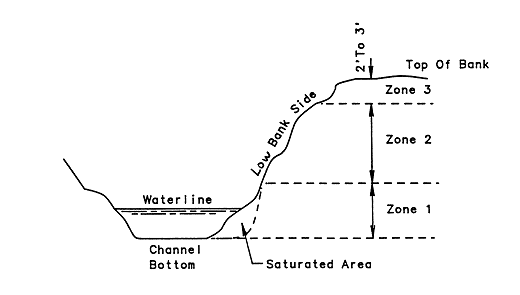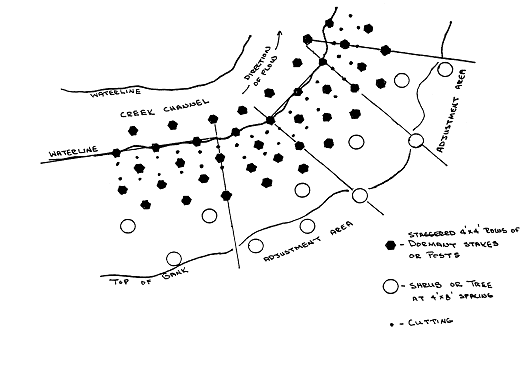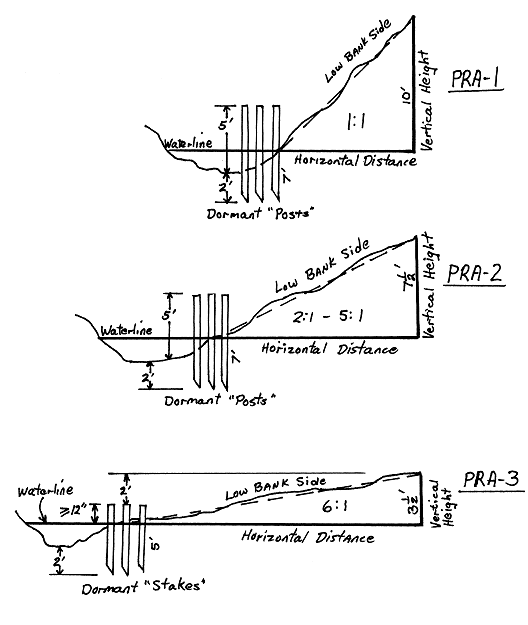 |
Construction
Specification
750. USE OF WOODY PLANTINGS FOR STREAMBANK STABILIZATION
1. SCOPE
Dormant woody planting, as referred to in Practice Standard 995-Vegetative Streambank Stabilization, is the use of live dormant stem cuttings of woody plant species of one-half inch to over three (3) inches in diameter for the purpose of vegetatively reproducing a selected tree or shrub species. This work shall consist of furnishing and installing the necessary vegetative materials, woody or grass species, as specified in Section 7 of this specification or related standard drawings.
2. PREPARATION AND HANDLING OF MATERIALS
The proper preparation and handling of selected materials is very important. The following guidelines will increase the chances of success:
a. Always select healthy materials native or adaptable to the planting site.
b. Make clean cuts and avoid split ends. Cutting tools to be used, including pruning shears, bow saws, chain saws, etc., should be based on the diameter of materials to be cut.
c. Always plant materials with the butt end down. The butt end should be tapered to mark it for proper orientation as well as facilitate driving it into the soil if done so manually. The top end should be flat, especially on stakes and posts, to facilitate manual driving (see Figure 1).
d. Trim lateral branches as shown in Figure 1 to leave the bark ridge and branch collar intact.
e. The diameter and length of the plant materials varies with the type:
Dormant "cutting" - The diameter of cuttings shall be a minimum of one-half inch and a maximum of less than one (1) inch. Cuttings shall be at least 12 inches but less than 18 inches in length.
Dormant "stake" - "Stakes" will be one (1) to three (3) inches in diameter at the top and 30 inches to six (6) feet in length.
Dormant "Posts" - "Posts" will be greater than three (3) inches in diameter at the top end. Length will vary with the depth to saturated soil and the difference in feet between the channel bottom and low bank elevation. However, posts will be a minimum length equal to the difference in feet between the lowest point of channel scour and the low bank elevations or 7 feet, whichever is less.
All "stakes" and "posts" shall extend a minimum of two (2) feet below the maximum depth of the streambed scour.
f. At least two (2) lateral buds and/or terminal bud scars will be above the ground on "cuttings". It is recommended that a terminal bud scar be located within 1 to 4 inches of the top. Cuttings put out the largest number and strongest shoots just below a terminal bud scar (annual growth scar).
g. Planting materials must not be allowed to dry out. They will be kept moist and covered during transport to the planting site and during planting operations. Material will be kept submerged in water up to the time of planting. It is best to plant materials the same day they are cut and prepared. One exception to this is eastern cottonwood which has exhibited increased survival rates if soaked in water for 1 to 2 days prior to planting.
3. SITE EVALUATION
A number of considerations will be addressed during the planning and design phases of a streambank stabilization project. Some of these considerations include:
a. Streambank Characteristics - What is the stream channel bottom to low bank height difference for determining minimum "post" length, the existing bank slope or planned bankslope to determine the row placement requirements, and the existing vegetation in relation to its incorporation into the final project design?
b. Soil Types - What soil type(s) are present and what plant species will grow well on the site, especially in relation to tree, shrub and grass/legume species planted in the riparian zone? How stable are the soil types present on the project site(s)?
c. Stream Channel Characteristics - The important consideration here is the stability of the channel bottom. This method of stabilization will be limited to those streams with a stable channel bottom characterized by the lack of channel scour and overfalls and having a typical "meandering" channel.
See "Streambank Stabilization Site Evaluation Worksheet" at the end of this specification for additional information.
d. Equipment, Time and Costs - Based on the above items, what kind of equipment will be needed to prepare the site and install the planting materials? How many man-hours will be required to complete the project? How much will it cost, including equipment, materials and labor?
4. SPECIES TO PLANT
For dormant planting materials, select native or naturalized species that are known to root readily with or without the use of rooting hormones. Rooting hormones, if used, shall be applied according to manufacturers' recommendations. Eastern cottonwood (Populus deltoides) and Black willow (Salix nigra) are native species which root readily without hormonal treatments.
Woody species with short, dense, flexible top growth and large, deep, fibrous root systems are recommended. Other desirable characteristics include rapid initial growth, ability to reproduce by seed or vegetatively, and resistance to insects and diseases.
Species suitable for use as planting materials or bare-root planting stock are listed in Table 1.
5. DESIGN AND LAYOUT
Spacing of dormant "stakes" and "posts" will be on 2'x 2', 2'x4', or 4'x4' staggered spacings. Dormant "cuttings" may be scattered between rows of "stakes" and "posts" in Plant Zone 1 and the lower one-half of Plant Zone 2 (see Figure 3 for a sample layout).
On eroding streambanks over 15 feet high, a minimum of 4 rows of dormant "stakes" or "posts" will be included in the design.
Planting row arrangement shall conform to those minimums listed in the standard and specification for this practice (see Figure 4).
6. INSTALLATION
Dormant planting materials must be properly installed to improve the chances of success. The following guidelines shall be followed:
a. Be sure that the planting material is planted correctly. (Butt end in the ground.)
b. Set the materials as deep as possible with at least the bottom 12 inches into a saturated soil layer. Deep planting insures an adequate moisture supply for root development, minimizes water loss due to transpiration and prevents root breakage caused by movement between the planting material and the soil during high velocity water flows.
c. Avoid excessive damage to the bark of the planting material, especially stripping.
d. Be sure there is good contact between the soil and planting material. "Dormant cuttings" will have the soil tamped around them. Dormant materials may be installed using an iron bar for "cuttings" and a post hole digger, powered auger or a metal ram on a backhoe or similar equipment for "stakes" and "posts". In soft, non-restricted soils, "stakes" or "posts" may be manually driven into place using a wooden maul. If a sledge is used, care must taken to avoid splitting the planting material. Extreme care in driving the stakes or posts is needed and shall be limited to those soils where use of the other methods is not feasible, such as sandy soils. Post lengths will be extended 4" to 6" to allow for a new flat cut to eliminate any damaged materials after manual driving. At least 40 percent, and preferably 50 percent or more, of the planting material shall be below ground level after planting.
e. Where damage by beaver may occur, treating materials with a repellant, such as ropel, or enclosing them with chicken wire is recommended.
f. All "stakes" and "posts" located in the stream channel shall have a minimum of 12 inches extending above the normal water level.
All materials will be cut and installed while in a dormant stage. Therefore, the following periods will be used for practice installation: November 1 until ground becomes frozen or February 1 to April 1 provided ground is not frozen or buds have not broken dormancy.
7. SPECIAL SITE SPECIFICATIONS
Species selection shall consider the position of the plant in the bank profile (see Figure 2).
Zone 1 - Below normal waterline to upper limit of saturation area kept moist by capillary water movement. This zone includes the greatest potential for periodic inundation and the least moisture stress.
Zone 2 - Area from upper limit of Zone 1 to 2-3 feet from the top of the bank. This area may be subject to rapid drying and greater moisture stress.
Zone 3 - Area 2-3 feet below the top of the bank to a minimum of 30 feet into the floodplain (riparian area)
Table 1.
Recommended Woody Species for Streambank and Shoreline Protection
|
Plant |
Common Name |
Genus Species |
Growth Form |
|---|---|---|---|
|
1 |
* Black Willow |
Salix nigra |
Tree |
|
1 |
* Bankers Willow |
Salix cottettii |
Shrub |
|
1 |
* Purple-osier Willow |
Salix purpurea |
Shrub |
|
1 |
* Sandbar Willow |
Salix interior |
Tree |
|
1 |
* Carolina Willow |
Salix caroliniana |
Tree |
|
1 |
* Peach-leaved Willow |
Salix amygdaloides |
Tree |
|
1 |
* Buttonbush |
Cephalanthis occidetalis |
Shrub |
|
1,2,3 |
* Red-osier Dogwood |
Cornus stolonifera |
Shrub |
|
2,3 |
* Silky Dogwood |
Cornus amomum |
Shrub |
|
2,3 |
Flowering Dogwood |
Cornus florida |
Tree |
|
2,3 |
Green Ash |
Fraxinus pennsylvanica |
Tree |
|
2,3 |
* Sycamore |
Platanus occidentalis |
Tree |
|
1,2,3 |
Baldcypress |
Taxodium distichum |
Tree |
|
1,2 |
River Birch |
Betula nigra |
Tree |
|
1,2,3 |
* Eastern Cottonwood |
Populus deltoides |
Tree |
|
1,2,3 |
* Swamp Cottonwood |
Populus heterophylla |
Tree |
* These species are suitable for use as dormant woody cuttings, stakes or posts. All species of willow and cottonwood do not require hormone treatment for rooting.
Any deciduous hardwood species listed in the corresponding Woodland Planting Group in the NRCS Field Office Technical Guide for the applicable soil type is suitable for planting as bareroot stock in zones 2 and 3.
Figure 1
Planting Material Preparation

Figure 2
Plant Zones

Figure 3
Sample Layout

Figure 4
Minimum Planting Row Arrangements (PRA)

Streambank Stabilization Site Evaluation Worksheet
1. Determine channel bottom to low bank height differences:
A = Elevation of low bank at lowest point on its profile = ______
B = Elevation of channel bottom at lowest point of channel scour = _______
C = Difference in elevation (A - B) = _______
2. Determine minimum length of "stake" or "post" required:
If difference (C) exceeds 5 feet – Use a minimum length of 7 feet.
If difference (C) is less than 5 feet – Use a minimum length equal to C.
3. Determine the ratio of horizontal distance to vertical height of the streambank (low bank side) for row arrangement to be used (see figure 4):
Example: Horizontal distance of streambank equals 12 feet vertical height of streambank equals 6 feet Horizontal distance to vertical height ratio equals 12:6 or 2:1
|
Horizontal Distance to |
Minimum Planting Row |
|---|---|
|
Steeper than 2:1 |
PRA-1 |
|
2:1 to 5:1 |
PRA-2 |
|
Flatter than 5:1 |
PRA-3 |
4. Will it be necessary to regrade the streambank to a different ratio? If yes:
A. To what ratio will the completed project be graded? ___:___
B. Based on "A" above, what PRA will be used? PRA-___
C. What equipment will be needed to complete the regrading?
______________________________________________________
______________________________________________________
5. Determine soil type(s) at the project site:
A. Predominant soil type(s) in the riparian zone for design purposes: __________________________________________________
B. Other major soil types present:____________________________________________
C. Determine Woodland Planting Group(s) (WPG) to use from Section II-F of the Field Office Technical Guide.
|
Predominant Soil Type(s) |
WPG |
Species to be Used |
|
1. _____________________ |
______ |
_________________________ |
|
2. _____________________ |
______ |
_________________________ |
|
3. _____________________ |
______ |
_________________________ |
D. Are predominant soil type(s) considered stable if properly protected? ________
If no, what alternative actions might be needed to assure stability? _____________________________________________________
_____________________________________________________
_____________________________________________________6. Determine stream channel bottom stability:
A. Does stream channel bottom have "overfalls" in or immediately below the project site? ________
B. Does the stream channel bottom continuously fluctuate in elevation due to scour holes? ________
C. Does the stream have segments of rushing water in an otherwise tranquil stream flow? ________
If any of the above can be answered "yes," careful evaluation by an experienced hydrologist may be needed before designing or installing this project.
7. Determine cost estimates: 1/
A. Equipment:_____ hours x ______/hour $_________
B. Labor: _____ hours x ______/hour $_________
C. Materials:_______________________ $________